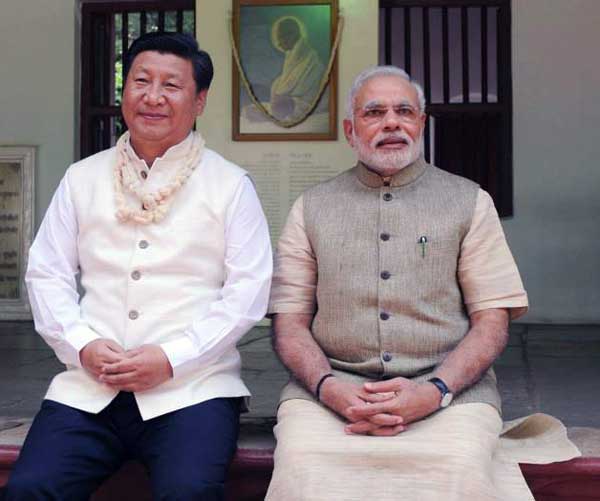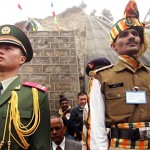On the Sep 18, India entered a new era when Prime Minister of India Mr Modi sitting next to the Chinese President Mr Xi Jinping briefed the press, categorically stating that peace and tranquility along the borders was imperative for mutual trust and for realizing the full potential of Sino-Indian relations.”This is an important understanding, which should be strictly observed,” Modi said as he raised “serious concerns” over what India calls serial transgressions by the Chinese.
The symbolic PLA’s serial transgressions as one may call have this time been met with a prompt counter action by Indian Army.
I wonder how many of us would recall the national pride being served in the righteous earnestness while dealing with China. The defeat of 1962 border war at the hands of PLA had injured the Indian psyche so deep that the reflections of insecurity were evidently visible as latest as 2013.
First incident that speaks by itself is the 2008 Olympic torch movement of two kilometers from Vijay Chowk to India gate. Unprecedented measures taken by Manmohan government to prevent Tibetan protesters from demonstrating close to the event is a sad reminder of the Chinese fright. Our government deployed 20000 troops of para-military and the police, blocking all roads leading to India Gate. Tibetan refugees were beaten mercilessly to please the big brother.
The second incident was that of Daulat Beg Oldie transgression of 2013. Chinese had camped 19 kilometers inside our territory. The then Government of India tried to suppress this information rather too hard. Once it failed, they set out to minimize what the Chinese had done. Indian foreign minister equated it to “Acne” and tried to trivialize the issue. To a question “why the Chinese had intruded 19 kilometers into our territory?” Foreign minister replied that he did not even look for it. It is not clear why it happened. Shamelessly he went ahead with his visit to Beijing stepping over the national pride.
The only incidents where India acted decisively was in six days border skirmish at Nathula in Sep 1967 and Sumdarongchu valley in 1987. These two incidents were so far the only two strong tactical actions conveying strategic message tothe Chinese belligerent transgressions. I have my doubts if these actions emanated solely out of political will largely guided by the bureaucrats who hold key to India’s fate. The strength of the military in all aspects; its leadership, morale and preparedness would have definitely contributed towards according sanction by Smt Indra Gandhi and later Mr Rajiv Gandhi to the military advice and the actions thereof. Daughter and grandson of Nehru understood too well the consequences of ignoring professional military advice. Thankfully so India could convey a strong message to the Chinese.
…the government at Delhi allowed Tibetan protesters to peacefully demonstrate near Hyderabad house when the two powerful leaders were involved in a bilateral discussion. This was something unimaginable if those with the Nehruvian descent were in power.
However at diplomatic level India was weak kneed whenever the Chinese question confronted its leaders. Strong military action unsupported or complimented by weak diplomatic and political actions or vice-a-versa yield no concrete results leaving the national pride at the risk of being compromised. It is worth recalling what a Chinese General told the Indian delegation in 1988 led by Mr Rajiv Gandhi and ND Tiwari to diffuse border tensions. He relayed the warning that China would “teach India a lesson” if it did not cease “nibbling” Chinese territory.
Taking advantage of our meek character, our neighbours even as small as Maldives have shown disregard to our concerns in the recent past.
This time around things appear to be set for a change. Nehru in 1950 acknowledged Tibet as integral part of China. He literally ridiculed Panikar, the Indian ambassador to Peking when the later expressed concerns about the Chinese designs in Tibet. When the Dali Lama escaped to India seeking asylum, Nehru rushed to Mussoorie where this spiritual leader was housed and tutored him for two hours virtually scolding his action of coming to India thus jeopardizing peace in the region. Stifled between the realism and idealism Nehru had to accord asylum to Dalia Lama.
Ever since 1950 we have continued with our stated stand on Tibet being integral to China on all forums but not so this time in Delhi at the Joint Press Conference by Modi and Xi. So what has changed needs to be listed and this is as follows:
- For the first time over the years that memory can scan, military response at the LAC to counter the PLA’s transgression at Chumar in Ladakh and political will in Hyderabad House New Delhi was in total sync signaling a strong India.
- The symbolic PLA’s serial transgressions as one may call have this time been met with a prompt counter action by Indian Army. The 1000 PLA troops were contained by nearly 1500 Indian troops occupying tactical heights supported by adequate reserves signaling serious business.
- Indian Prime Minister professed regional peace and stability by denouncing expansionist policy of some nations, clearly hinting at China from the Japanese soil.
- Just before the Chinese president’s visit to India we agreed to oil exploration in two oil blocks allotted by Vietnam in South China Sea brushing aside Chinese concerns.
…the first time India has not parroted about Tibet as an integral part of China at the Joint Press Conference after the summit level talks. This has signaled Tibetan leverage India may exercise in future.
- Most significantly the government at Delhi allowed Tibetan protesters to peacefully demonstrate near Hyderabad house when the two powerful leaders were involved in a bilateral discussion. This was something unimaginable if those with the Nehruvian descent were in power.
- And for the first time India has not parroted about Tibet as an integral part of China at the Joint Press Conference after the summit level talks. This has signaled Tibetan leverage India may exercise in future.
- Not to miss out, India has opened railways and space, its strategic sectors for Chinese investment amongst others signaling ‘inching forward to cover the miles’.
When the world spotted the Tibetan Prime Minister in exile attending the swearing in ceremony of Mr Narender Damodar Das Modi as the Prime Minister of India, the message was amply clear. The winds were blowing the other direction and soon the people around should get used to it.
Manifestation of Modi’s Realism over Nehru’s Idealism has just begun.






Truly Modi Ji is right on path of ready to change to make India take pride as a sovereign country of respect and dignity. This is in tune with what Vivekananda had rightly predicted that India will arise awake and stop not to regain its supremacy as a spiritual leader of the world.
Superb…only one word
What is the counter action that the Army was able to take against the PLA this time around? Media reports suggested that there was an eyeball-to-eyeball confrontation well inside Indian side of the LAC with the Chinese soldiers and civilians refusing to budge. This was the largest intrusion by PLA in terms of numbers (about 1000 soldiers). On the ground there seems to have been no concrete action which would have deterred the PLA from engaging in incursions along the LAC. Modi Realism seems to have coincided with Nehruvian Idealism at least this time around.